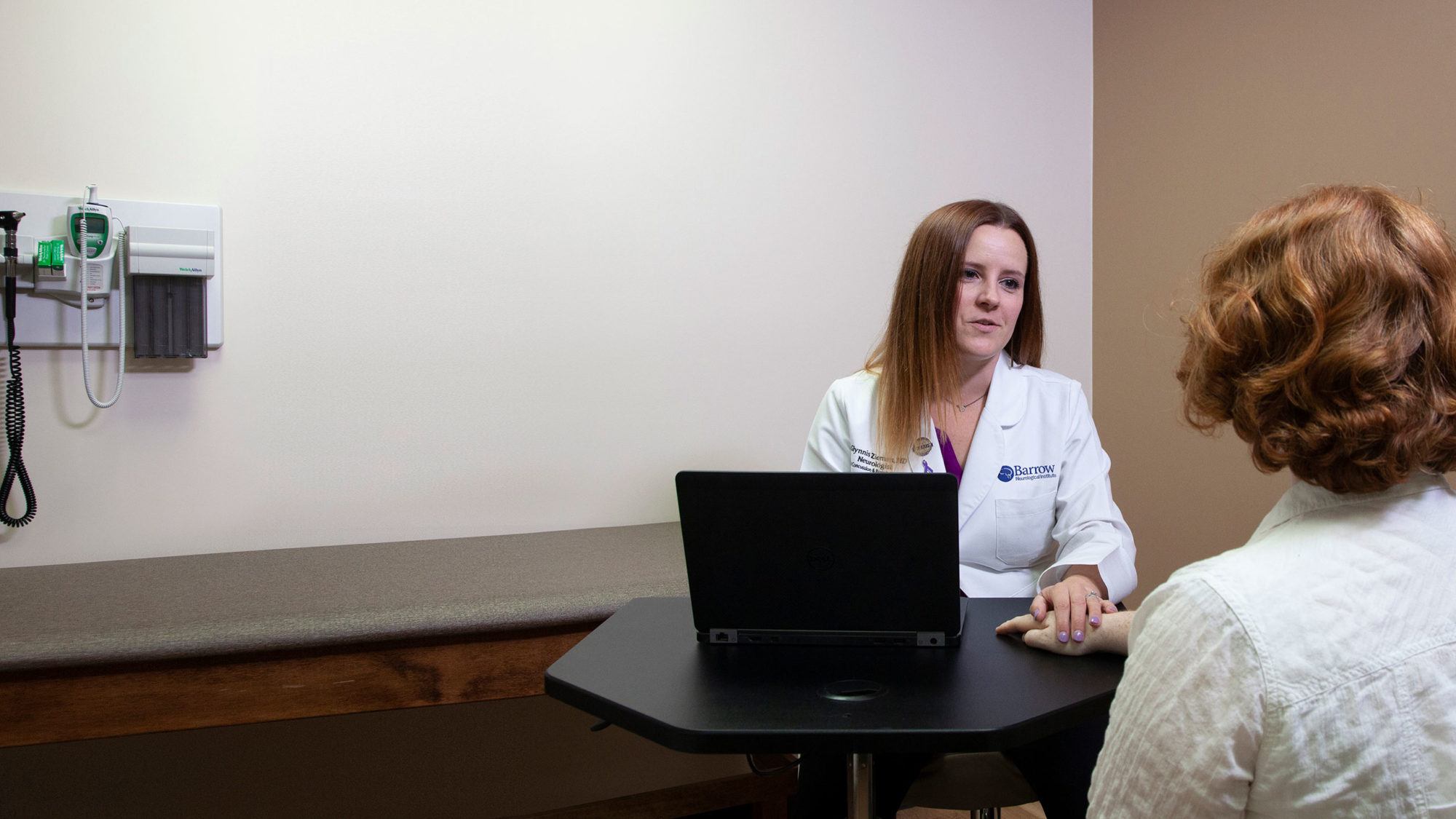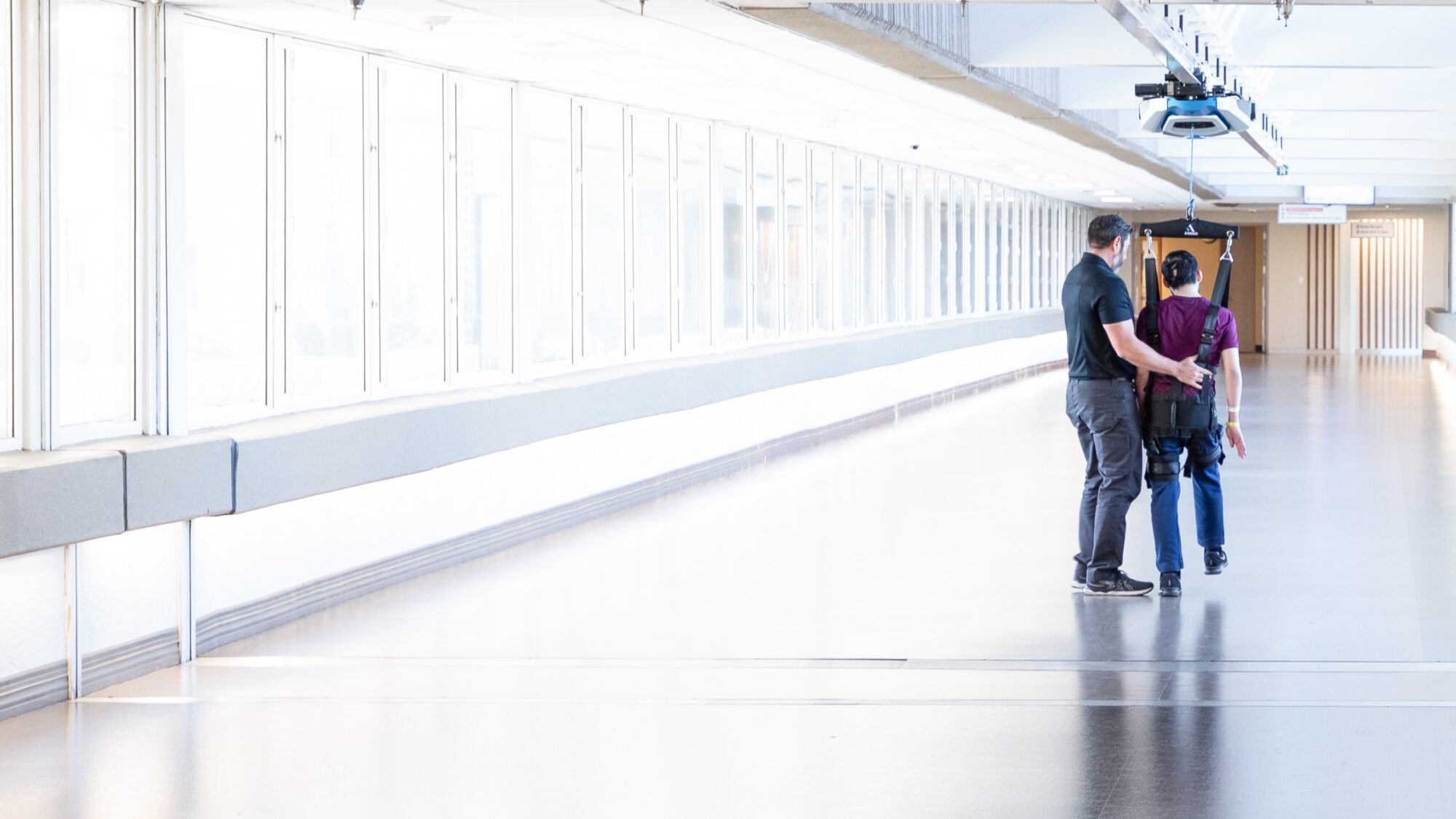
Traumatic Brain Injury (TBI)
Overview
A traumatic brain injury (TBI) occurs when a bump, blow to the head, strong shaking motion like in a car crash, or penetrating injury like a bullet or shrapnel disrupts the normal function of the brain.
The effects of a TBI depend on its severity and the location of the injury. TBIs can cause temporary or short-term problems with brain function, like confusion or a transitory headache, or they can lead to long-term issues, like memory loss or mood and behavioral changes.
Most of the TBIs that happen each year are concussions, or mild TBIs. However, more serious TBIs, known as moderate to severe traumatic brain injuries, can lead to lifelong disability or death.
What causes a traumatic brain injury?
The most common causes of traumatic brain injuries (TBIs) include:
- Falling: As the leading cause of TBIs, especially in young children and older adults, falling can be caused by many events, like tripping on stairs, slipping in the shower, falling off a ladder, or losing footing on icy pavement.
- Motor vehicle accidents: Sudden stops or collisions in cars, trucks, or on motorcycles can cause the brain to slam against the inside of the skull and result in a TBI.
- Being struck by or against an object: This is common in sports, work injuries, or even everyday accidents. It can include a ball unexpectedly hitting someone’s head or accidentally walking into or standing up and hitting a hard object.
- Sports and recreation injuries: Concussions have become a growing concern for athletes and are especially common in football, soccer, hockey, skateboarding, and boxing.
- Combat injuries and explosions: Common among military personnel, these combat injuries and explosions can include blasts that jolt the brain, even if there’s no direct impact.
- Assaults or violence: Domestic abuse, physical fights, and gunshot wounds can all lead to TBIs. A form of child abuse known as shaken baby syndrome is also a cause of TBI in infants.

Traumatic Brain Injury (TBI) Symptoms
Symptoms of a traumatic brain injury (TBI) will depend on how severe the injury is and which part of the brain is affected. They can be mild, moderate, or severe; some may appear right away, while others may take hours or days.
In a mild TBI, symptoms can include:
- Headache
- Confusion
- Lightheadedness
- Dizziness
- Sensitivity to bright lights or loud sounds
- Blurred vision, double vision, or tired eyes
- Ringing in the ears, known as tinnitus
- Changes in the ability to smell or a bad taste in your mouth
- Fatigue, drowsiness, or lethargy
- A change in sleep patterns, like sleeping more or less than usual, or trouble falling asleep
- Behavioral or mood changes, like irritability or sudden mood swings, or a new onset of anxiety or depression
- Trouble with memory, concentration, or attention
- Slowed thinking or difficulty making decisions and solving problems
- May remain conscious or may experience a loss of consciousness for a few seconds or minutes
In a moderate-to-severe TBI, the symptoms of a mild TBI will be present, but you may also experience one or more of the following:
- An initial headache that gets worse or does not go away
- Dilation of one or both pupils of the eyes
- Slurred speech
- Weakness or numbness in the extremities
- Loss of coordination
- Increased confusion, restlessness, or agitation
- Repeated vomiting or nausea
- Convulsions or seizures
- For a moderate TBI, losing consciousness lasting more than 30 minutes but fewer than 24 hours
- In a severe TBI, losing consciousness for more than 24 hours
- An inability to awaken from sleep
In young children who are unable to articulate how they feel, TBI symptoms can look like crying more than usual, trouble sleeping or feeding, difficulty walking or talking, seeming more tired or cranky, and a loss of interest in favorite toys.
If you experience or observe any of these symptoms in another person, please seek immediate emergency care within the first 24 hours of injury. Persistent or worsening symptoms could be a sign of a more severe brain injury. A doctor should evaluate them immediately in an emergency department.
Traumatic Brain Injury (TBI) Diagnosis
Physicians diagnose a traumatic brain injury (TBI) using a combination of symptoms, physical and neurological exams, and occasionally imaging tests. The goal is to determine how severe your injury is and what part of the brain might be affected.
The following comprehensive exams and testing can help diagnose a TBI:
- Physical and neurological exam: First, your healthcare provider will ask you about what happened and how you’re feeling, how long your symptoms have lasted, and whether your symptoms affect your work, school, sleep, or everyday life. Next, they’ll complete a neurological exam by checking your balance, reflexes, coordination, sensation, and eye movements. They may ask you to perform simple neurocognitive tests to assess how well your brain processes information. This helps your provider rule out more serious brain injuries or other potential causes.
- Glasgow Coma Scale (GCS): The Glasgow Coma Scale (GCS) is a quick tool used by providers to measure the level of consciousness after a head injury. It assigns numbers to eye-opening, verbal, and motor responses. A GCS score of 13-15 indicates a mild TBI, 9-12 indicates a moderate TBI, and 3-8 indicates a severe TBI.
- Post-traumatic amnesia: Memory gaps before, during, and after TBI are common. The duration of amnesia can help classify the severity of TBI. Post-traumatic amnesia lasting up to 24 hours indicates a mild TBI, post-traumatic amnesia lasting up to a week indicates moderate TBI, and amnesia lasting more than one week indicates severe TBI.
- Loss of consciousness: Although the majority of concussions don’t cause loss of consciousness, it can occur in mild, moderate, and severe TBI. The duration of loss of consciousness helps guide the classification of TBI severity. Loss of consciousness of up to 30 minutes indicates mild TBI, 24 hours indicates moderate, and over 24 hours indicates severe.
- Blood tests: Blood tests are beginning to help diagnose TBIs because they can detect specific proteins released into the bloodstream after a brain injury. These proteins are called biomarkers, and two of the most studied biomarkers are GFAP (glial fibrillary acidic protein) and UCH-L1 (ubiquitin C-terminal hydrolase-L1). High levels of either can indicate a TBI.
- Computed Tomography (CT): Using a series of cross-sectional X-ray images, a CT scan is the standard test to analyze the adult brain immediately after an injury to see if there’s bleeding, bruising, swelling, or skull fractures. CT scans are only used in children under certain circumstances to limit their radiation exposure.
- Magnetic Resonance Imaging (MRI): Using more detailed images, your doctor may recommend an MRI if your symptoms worsen to assess any subtle injuries, bleeding, or brain swelling.
The Brain Injury & Sports Neurology Center at Barrow Neurological Institute
The Brain Injury & Sports Neurology Center at Barrow Neurological Institute offers cutting-edge treatment for adults and adolescents with concussions, TBI, and neurological conditions in athletes in one inclusive location. While our highly trained specialists excel in treating all manner of post-concussion symptoms, we’re also forging a new path forward in how the U.S. addresses concussions in youth and high school sports. We’ve even developed a program to help survivors of domestic violence who have suffered concussions or TBIs as a result of abuse.

Traumatic Brain Injury (TBI) Treatment
The range of treatments for traumatic brain injuries (TBIs) depends on how severe the injury is and the symptoms or complications that follow. Generally, treatment for a TBI involves a mix of rest, medications, neuro-rehabilitation therapies, and, occasionally, surgery.
Nonsurgical Treatments
Most mild TBIs can be managed without hospitalization, although initial treatment in an emergency room may be necessary. This treatment can look like medical personnel stabilizing you or your loved one to prevent further injury, ensuring proper oxygen supply to your brain and the rest of your body, maintaining adequate blood flow, and controlling your blood pressure.
For most mild TBIs, the recommended treatment is an abundance of physical and mental rest, followed by gradually returning to activities under the guidance of a healthcare professional. In the earliest stages of a mild TBI, the doctors recommend the following measures:
- Physical rest: Avoid physical activities that can exacerbate symptoms, such as physical exertion, exercise or sports, and vigorous movements.
- Cognitive rest: Reduce activities that require significant mental effort, like watching TV, reading, texting, studying, or playing video games.
- Pain relief: Acetaminophen (Tylenol) can help with headache pains, although other pain medications, like ibuprofen and aspirin, are generally avoided because they can increase the risk of bleeding.
- Close monitoring for worsening symptoms: For the first 48 hours, it’s essential to watch for symptoms like vomiting, confusion, or severe headache.
After the first 48 hours, you may gradually return to activities as long as the activities are well tolerated. These activities must strike the right balance between too much and too little, which will look different for every person. To start:
- Symptom-limited activity: Begin with light activities that don’t worsen symptoms, like easy household tasks or short walks. Light cognitive activities, like reading, can be added, and screen time can gradually resume.
- For a return to work: Your healthcare team may recommend you have shortened school days or workdays with modified or reduced workloads while you recover. Different rehabilitative therapies, like physical or occupational therapy, can also occur during this time.
- For a return to sports: To return to sports, you must advance through the following stages by remaining symptom-free in each one. These stages include:
- Light aerobic exercise, like walking or stationary cycling.
- Sport-specific exercise, like running drills without head impact.
- Non-contact training drills, like passing drills in football.
- Full-contact practice after medical clearance, followed by a return to regular play.
However, depending on your sport and the severity of your TBI, a more thorough examination may be needed before you can return to contact sports.
Listening to your body is often the best barometer of recovery from a mild TBI: If your symptoms worsen, it’s a prompt to stop whatever you’re doing and take a break. Trying to power through can prolong recovery time.
In moderate to severe TBIs, intensive nonsurgical or surgical treatment is required to stabilize the brain, limit damage, and support recovery. In fact, most moderate to severe TBIs require emergency interventions, including stabilizing oxygen and blood pressure, monitoring intracranial pressure, and using medications to reduce swelling.
In critical cases, doctors use coma-inducing drugs to protect the brain from further damage by reducing its activity and metabolic needs. Patients will often go straight to the intensive care unit (ICU) to protect the brain and prevent secondary damage.
Other treatments given to moderate to severe TBI patients can include:
- Oxygen therapy: This helps ensure the brain continues to receive enough oxygen.
- Ventilation: If you or your loved one can’t breathe on your own, doctors may use a ventilator.
- IV fluids and blood support: These treatments help maintain blood flow.
- Sedatives and pain control: Together, these treatments help the body rest, calm the brain, and reduce stress and metabolic demand during healing.
- Anti-seizure medication: Also known as antiepileptic drugs, these medications prevent or treat post-traumatic seizures and their complications.
- Feeding tubes: If you or your loved one is unconscious or has difficulty swallowing, feeding tubes will maintain a healthy level of nutrition.
These nonsurgical treatments support brain recovery, prevent further harm, and help you or your loved one relearn how to function. Once stable, the focus will shift to restoring brain and body function through rehabilitation, which can include:
- Physical therapy: This therapy focuses on improving balance, strength, and coordination.
- Occupational therapy: The goal here is to support the relearning of useful everyday tasks, like dressing, feeding oneself, and cooking. It also helps with vision.
- Speech and language therapy: This therapy can support speech, language, and cognition recovery, as well as any swallowing issues that can occur after TBI.
- Neuropsychological therapy: This therapy focuses on improving memory, concentration, mood, and executive function.
- Mental health support: Counseling, behavioral therapy, coping skills, trauma recovery, and sometimes medications, like antidepressants or anti-anxiety medications, are used.
Surgical Treatments
Surgery for a traumatic brain injury (TBI) is typically only needed for moderate to severe cases, when there’s bleeding, pressure, or damage that puts brain function or survival at risk. In the event surgery is needed, a neurosurgeon might perform the following procedures:
- Craniotomy: During a craniotomy, a neurosurgeon makes an incision in the scalp and removes a portion of the skull. Then, using intraoperative imaging and highly specialized tools, the surgeon visualizes and accesses the brain to stop active bleeding, remove a blood clot, repair damaged blood vessels, or relieve pressure from swelling or fluid buildup. At the end of the procedure, screws and plates secure the removed piece of the skull bone back into place.
- Decompressive craniectomy: Similar to a craniotomy, in a craniectomy, a neurosurgeon removes a piece of skull, but does not replace it until brain swelling goes down. During a second surgery, the piece of skull is replaced. This procedure gives the brain room to swell safely. Neurosurgeons use a decompressive craniotomy only in cases of extreme brain swelling that isn’t responding to medication, where the pressure has become life-threatening.
- Evacuation of blood clots: Also known as hematomas, this procedure is used when blood pools inside the brain or between the brain and the skull and is surgically removed. If the hematoma is small and close to the surface of the skull, neurosurgeons may use a less invasive burr hole drainage approach. However, if the clot is large or deep, a craniotomy is needed. In either instance, a hematoma has to be removed because it can press on the brain and cut off blood flow, resulting in permanent damage.
- Skull fracture repair: If the TBI has caused a depressed skull fracture, where bone fragments press into the brain, a neurosurgeon will elevate the bone, clean the area to prevent infection, and fix the protective layer covering the brain. This surgical procedure is done when there are open or compound fractures in the skull, when brain tissue or meninges are exposed, or cerebrospinal fluid (CSF) is leaking.
- Ventriculostomy: This procedure involves placing a catheter into a brain ventricle to measure brain pressure and drain excess cerebrospinal fluid (CSF). It is only used when brain swelling is suspected or ongoing or as part of pressure management after a severe TBI.
Recovery from surgery after a moderate to severe TBI will depend on the type of surgery done, the severity of the initial injury, and a person’s age and overall health. While some people bounce back quickly, others may need months or even years of rehabilitation.
Neuro-Rehabilitation for Brain Injuries at Barrow Neurological Institute
The Neuro-Rehabilitation Center at Barrow Neurological Institute is one of the leading clinics for brain injury rehabilitation in the U.S. From injury prevention to maintaining an active and healthy lifestyle after rehabilitation, our team of experts is committed to helping patients with brain injuries through every step of their experience.
Neuro-rehabilitation helps people who have experienced complex brain and spinal cord diseases, injuries, and conditions return to normal functioning or regain as much function as possible. The guidance, support, and assistance of various professionals are crucial to this process. It’s never too late to start a neuro-rehabilitation program—many people can enjoy meaningful improvement and regain function months or even years after an initial injury.
Common Questions
How common are traumatic brain injuries?
Each year, between 2.5 and 2.8 million Americans sustain a traumatic brain injury (TBI)—or about one every 15 seconds.
Of these, approximately 2.5 million people receive treatment in emergency departments, up to 282,000 of these 2.5 million are hospitalized, and sadly, up to 60,000 do not survive.
Mild TBIs—known as concussions—make up 75 to 90 percent of all reported brain injuries.
Who gets traumatic brain injuries?
The leading cause of traumatic brain injuries is a fall, which disproportionately affects the youngest and oldest age groups.
According to the CDC, falls lead to more than half of TBIs among children 14 years and under, while causing more than two-thirds of TBIs in adults 65 and older. Young children are especially vulnerable to TBI because they have relatively large heads supported by a weaker neck, compounded by incomplete or immature motor development. This makes children naturally clumsy, and their heavy heads can take the brunt of impact.
TBIs can happen to anyone, but certain groups are more at risk:
- Young children 4 years and under, teenagers, and adults between the ages of 15 and 24 are at high risk.
- Adults aged 65 and older have the highest rates of TBI-related hospitalizations and deaths.
- Men are about twice as likely as women to sustain a TBI, and tend to have more severe outcomes. Statistically, men are three times more likely to die from a TBI than women. According to the CDC, men experience a TBI-related death rate of 28.3 per 100,000. In contrast, women experience a TBI-related death rate of 8.4 per 100,000.
What is the prognosis for someone with a traumatic brain injury?
Mild traumatic brain injuries (TBIs)–also known as concussions—usually heal. Still, lingering symptoms from concussions, called persistent post-concussion symptoms, can be common in up to 20 percent of individuals. Most people fully recover from their mild TBI within a few weeks or a few months.
Moderate-to-severe TBIs can produce lasting challenges, but early treatment and proper rehabilitation significantly improve outcomes. Between 30 and 50 percent of moderate-to-severe TBI patients experience long-term disabilities, and the quality of life post-TBI can vary considerably.
Moderate to severe TBIs often have long-term consequences. People with a history of moderate-to-severe TBIs are at a greater risk of depression, anxiety, and PTSD, and, in the long term, TBIs increase the risk of epilepsy, Parkinson’s disease, Alzheimer’s disease, and dementia. That said, survival rates from moderate-to-severe TBIs are improving due to better emergency care.
Can traumatic brain injuries be prevented?
Many traumatic brain injuries (TBIs) can be prevented, mainly because most are caused by things like falls, sports injuries, and car accidents. While not every TBI is avoidable, a lot of the risk comes down to situations we can individually manage or protect against. Prevention tips include:
- Falls: As the leading cause of TBIs—especially for those over age 65—fall prevention can be as simple as installing grab bars, non-slip mats, and better lighting at home. It’s also encouraged through regular strength and balance exercises, checking vision regularly, and reviewing medications that may affect balance.
- Wearing helmets and safety gear: Helmets protect the skull and the brain inside it from direct impact. Activities that call for helmets include biking, skateboarding, riding scooters, motorcycles, and ATVs, contact sports like football, hockey, and lacrosse, skiing or snowboarding, and horseback riding.
- Drive and ride smart: Motor vehicle crashes are a significant cause of TBIs, but many are preventable. Always wear a seatbelt, even in the back seat, and use child safety seats correctly. Ensure you follow posted speed limits and avoid distracted driving, such as texting while driving. Lastly, never drive under the influence of alcohol, drugs, or while extremely tired.
- Protect kids in sports: Sports-related TBIs are especially common in football, soccer, hockey, lacrosse, and boxing. To reduce the risk of TBI, make sure your kids wear properly fitting helmets, report and rest after a suspected concussion, and enforce a return-to-play protocol after a head injury.
- Manage risk in young children: Young children are especially prone to falls. For babies and toddlers, experts recommend that you use baby gates, window guards, and soft flooring, never leave them unattended on high surfaces, and always use properly-installed car seats.
- Practice caution around high-risk work or environments: Construction, military service, and industrial jobs carry a higher risk of TBI, requiring the consistent use of protective headgear and safety protocols. Ensuring workplace safety training is up-to-date is also an important prevention tool.
While assaults and domestic violence can lead to TBIs, it can be difficult to prevent abuse from another person. Community support, access to mental health care, and violence prevention programs matter, as do promoting safe home, school, and work environments.



